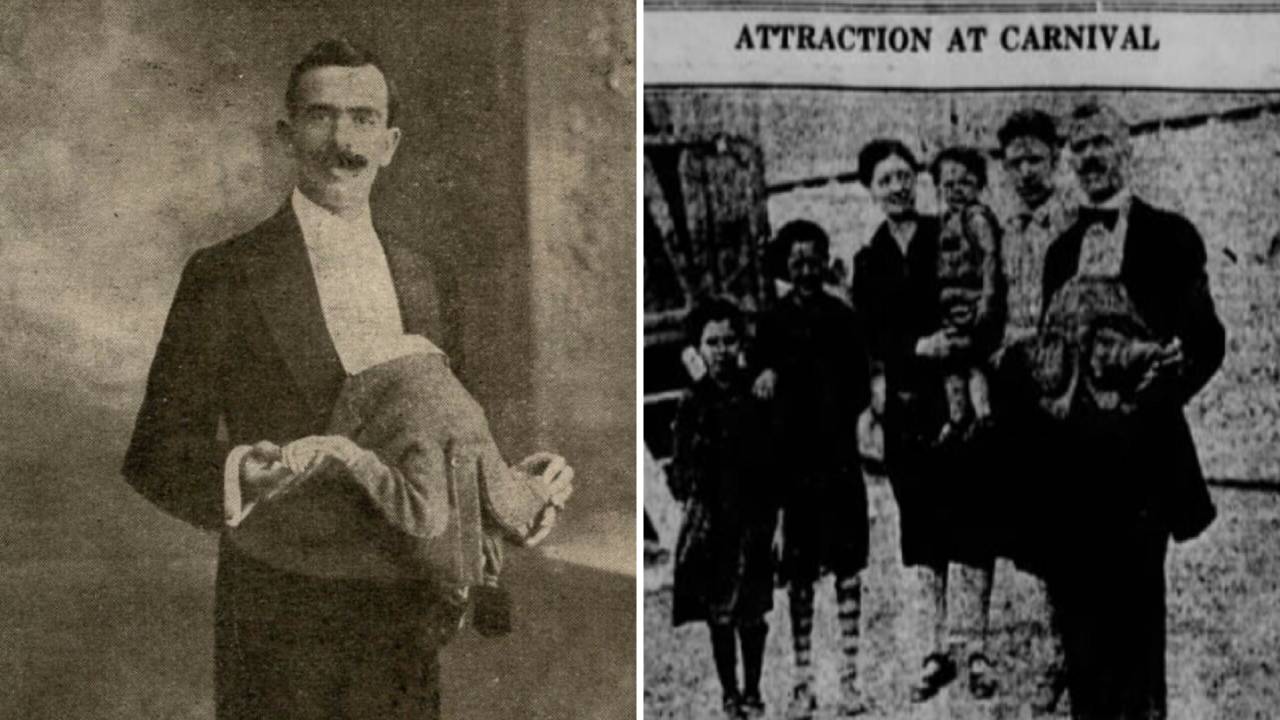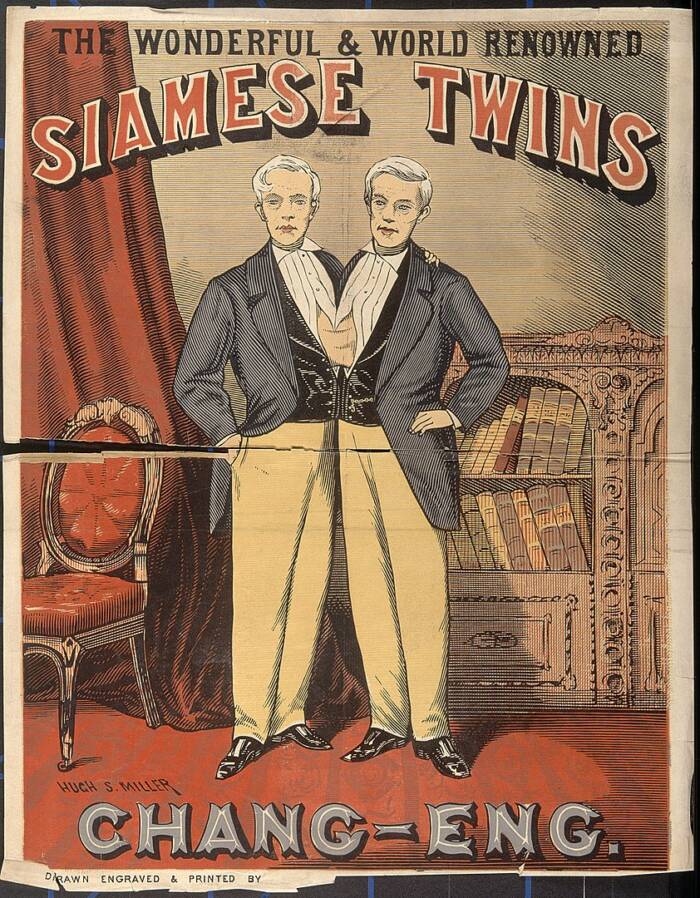
At the beginning of the 20th century, Jean Libbera performed in a circus alongside his brother Jacques. The curious thing? Jacques was his parasitic twin, attached to Jean’s chest and stomach. One of the strangest cases of conjoined twins in medical history.
The Strange Case of Jean Libbera and His Brother Jacques
In 1900, circus and sideshow audiences around the world were amazed to see Jean Libbera, called the “Man of Two Bodies.” Jean displayed his small twin growing attached to his torso.
Jacques had two arms, two legs, and a partially formed head embedded in Jean’s stomach, but he was completely dependent on his brother’s bodily functions to survive. As a result, Jean carried him throughout his life.
Despite his strange condition, Jean Libbera lived a normal life. He married, had four children, and lived until he was 50. However, with few records of his life beyond show advertisements, much of his story remains a mystery.
The Birth of the Man of Two Bodies

Jean Libbera was born in Rome in 1884 with a parasitic twin attached to his abdomen. He was one of 13 children, with one other sibling also born with a parasitic twin who did not survive past infancy.
Jacques was what is known as a vestigial parasite. This condition occurs when an embryo partially splits into twins, and the two sides develop asymmetrically in the womb. As a result, the smaller twin attaches to the larger one.
According to the Cleveland Clinic, conjoined twins are very rare, affecting only about one in every 50,000 pregnancies worldwide. Parasitic twins, on the other hand, represent about 10% of conjoined twins and affect less than one in a million births globally.
Since vestigial twins almost always die in the womb, nowadays, doctors usually remove the parasitic twin after birth to prevent the surviving twin from having medical issues.
By the late 19th and early 20th centuries, people with vestigial parasites often performed in circuses and sideshows, exactly what Jean Libbera did.
The Life of Jean (and Jacques) Libbera

Jean Libbera grew up to become a “Freak Show” performer, showing his small twin to curious audiences around the world. They often wore matching outfits in the shows.
“I don’t know if people actually fainted when they saw Jean Libbera,” said “freak show” photographer Diane Arbus, according to Rachel Adams’ book “Sideshow U.S.A.: Freaks and the American Cultural Imagination.”
“He looked a little melancholy in a poster on the far wall, standing in a tuxedo gently holding the hands of his vestigial twin, who grew head inward, poking out of his abdomen and wore small patent leather shoes and a diaper to avoid wetting his pants.”
Jacques had two small arms, two hands, two legs, and two feet. Normally, parasitic twins lack consciousness, but some reports said Jacques was alive and even moved, although he depended on Jean to survive. Jean and Jacques literally shared everything, including circulatory systems.
Marc Hartzman wrote in his book American Sideshow that Jean Libbera’s show brochures showed a very detailed X-ray, showing that Jacques’ partially formed head was inside Jean’s stomach and only measured 15 centimeters.
But with so few records of his life, it’s hard to know what was exactly true and what was exaggerated for the show’s benefit.
Offstage, Jean lived a relatively normal life, covering Jacques with a coat when going out. He also found a wife, with whom he had four healthy children.
Eventually, Jean Libbera retired from the shows and returned to Italy, where he died in 1934, at just 50 years old.
What Were the Biggest Challenges Jean Libbera Faced Due to Jacques’ Condition?
As anyone might imagine, Jean Libbera faced several significant challenges due to his parasitic twin, Jacques. The physical burden was immense, having to carry him throughout his life, especially since Jacques depended on all his brother’s functions to survive, as their circulatory and nervous systems were connected.
This led to Jean having medical complications, which also affected his twin. This meant that Jean had to be careful with his health throughout his life, avoiding excesses that would affect both of them. But when it came to health issues, the psychological aspect was likely the most problematic for Jean. Living under constant public scrutiny and curiosity must have affected his emotional stability. Although this allowed him to forge a career and make a living, the impact of being considered just a spectacle must have taken a toll, even though there are no psychological records of him.
Another aspect he had to face throughout his life was the difficulty of performing common daily activities. Jacques’ presence emerging from his back complicated any task, no matter how simple. As mentioned earlier, he had to cover his twin with a coat to lead a normal life and interact socially discreetly.
Another point to consider was his family. There is no record revealing what his married life was like, other than that he did get married and had four children. However, balancing his family life with his medical conditions and his career must have created significant emotional tension.
Other Conjoined Twins in the Circus. No existe un registro que revele como fue su vida de casado, más allá de que lo hizo y tuvo cuatro hijos. Sin embargo, equilibrar su vida en pareja con sus condiciones médicas más su carrera, debió generar una gran tensión emocional.
Other Conjoined Twins in the Circus

Jean Libbera and his brother Jacques were not the only ones to appear in circuses at the beginning of the 20th century:
Bunker Twins
One of the earliest documented and most well-known cases was the Bunker twins, Chang and Eng. In fact, the term “Siamese twins” was originally coined in reference to Siam, now known as Thailand, where they were born.
Both were perfectly healthy from birth, connected at the sternum and waist by just a few inches of tissue. Interestingly, both brothers married and had 21 children between them.
Hilton Twins
Another well-known but much more tragic case was the Hilton twins, Daisy and Violet. The two girls, born in England in 1908, were fused at the hips and pelvis. Their mother was unmarried, and shortly after their birth, her employer bought them to exhibit them as entertainment.
They began performing and touring from the age of three, under the strict care of Mary Hilton. The twins were practically enslaved by Mary and her husband, and later by Mary’s daughter when she passed away. They worked without pay, receiving beatings if they disobeyed.
In 1931, the sisters sued their managers and won emancipation. They continued to perform, but this time with an independent show. Their story inspired the famous Broadway musical, Side Show, which premiered in 1997 and was nominated for several Tony Awards.
Myrtle Corbin
At the beginning of the last century, Myrtle Corbin, better known as “The Four-Legged Girl from Texas”, was also famous. Corbin was born with a complete dipygus parasitic twin hanging from her abdomen, consisting of a perfectly developed small body from the waist down, including the genitals and reproductive system.
Myrtle began her career in the sideshow circuit at the age of 13. Her performances were very popular, earning her significant income, reportedly up to $250 a week at the peak of her career. Her fame led to several imposters trying to mimic her unique condition.
It’s a shame that there are no records of the life of Jean Libbera and his brother Jacques, as they would have helped medicine in previous years. Undoubtedly, one of the strangest cases of conjoined twins known to date.
